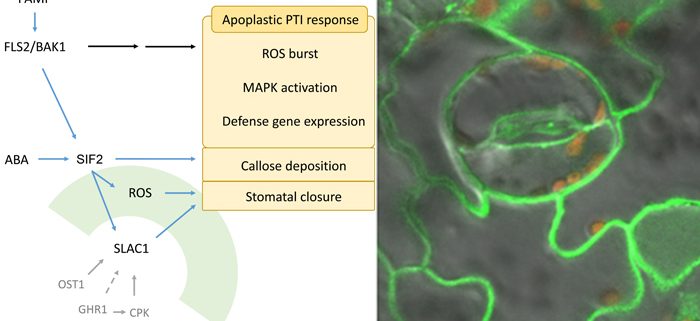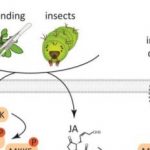A closed mouth catches no pathogens: how plants sense bacteria and regulate stomata
Chan, Panzeri, et al. show how a receptor-like kinase regulates stomatal immunity by phosphorylating an anion channel that mediates closure of stomata. Plant Cell. https://doi.org/10.1105/tpc.19.00578
By Ching Chana,b and Laurent Zimmerlia
aDepartment of Life Science and Institute of Plant Biology, National Taiwan University, Taipei 106, Taiwan.
bAgricultural Biotechnology Research Center, Academia Sinica, Taipei 115, Taiwan.
Background: Like humans, plants are regularly attacked by microbes such as fungi and bacteria. An easy way for bacteria to penetrate into plant leaf tissue is through pores known as stomata. Stomata are essential for normal processes such as gas exchange for photosynthesis and the maintenance of transpiration pull for re-distribution of water and minerals throughout the plant. One of the first lines of defense to block bacterial entry into leaves is to close stomata. To do this, plants first need to sense the presence of bacteria through sensor proteins that detect bacteria. These sensors are called immunity receptors. After immunity receptors detect bacteria, other proteins relay the defense signal to quickly initiate defense responses including closing stomata. Revealing how bacteria are detected and how the downstream defense signal works should facilitate the development of crops with increased resistance to bacteria.
Question: We wanted to explore how plants regulate stomatal opening and closure to balance normal growth and immunity against bacterial attack. We asked questions such as: what gene(s) is(are) the sensor (who)? What are the downstream mechanisms leading to bacterial resistance (how)?
Findings: Using the model plant Arabidopsis, we found that mutation of the gene STRESS INDUCED FACTOR 2 (SIF2) leads to reduced plant resistance to infection by bacteria, indicating that SIF2 is necessary for full bacterial resistance. Our investigation revealed that SIF2 mostly acts during stomatal immunity. SIF2 physically associates with a key immunity receptor complex. SIF2 protein has an intra-cellular kinase domain and during bacterial infection, this kinase domain mediates phosphorylation of the ion channel SLAC1 at position Serine65. Phosphorylation and activation of SLAC1 then leads to stomatal closure. SIF2 works at stomata to relay the defense signal from the bacterial sensor or immunity receptor complex, to a key downstream player, SLAC1, which induces stomatal closure to restrict bacterial entry into leaves.
Next steps: SIF2 belongs to the receptor-like kinase family. The Arabidopsis thaliana genome has more than 600 genes encoding receptor-like kinases. Next, we will decipher how they differ from each other: do they sense or modulate different signals? Do they function together as a supramolecular complex or alone?




